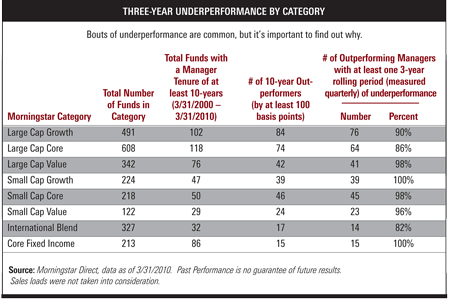We are swiftly approaching the end of the year, a time for annual portfolio checkups by both investors and advisors. Undoubtedly, during this process, you’ll find a mix of investment products that are exceeding, meeting, or missing performance expectations. It is the disappointments that garner the greatest share of mental exercise.
A common first step in the monitoring process for many advisors is to set up a simple checklist that tracks whether or not a product is meeting certain quantitative performance criteria (i.e. three-month, one-year, three-year, five-year trailing returns, etc). If a product is trailing the benchmark over a market cycle (a three- to five-year period, generally), the question arises: Is it time to make a change? It depends…
As much as we here at Prima Capital would like to believe we would never pick a manager that would underperform over a market cycle, it happens. It is not uncommon for a manager that has established a successful long-term track record to have lengthy stretches of time when they trail their best-fit benchmark. For instance, according to research we recently performed, there have been an overwhelming majority of top 10-year performers that have had bouts of three-year underperformance.
Across eight different Morningstar open-end mutual fund categories, we filtered for funds that have a 10-year track record, a portfolio manager that has been at the helm for the entire 10 years, and for those that have outperformed their respective benchmark by at least 1% on a 10-year annualized basis. We then measured how many of those funds had a least one rolling 3-year period of underperformance (see table below).
Stemming from our experience assessing the performance of managers, we offer general guidelines plus more specific considerations when evaluating underperformers.








 December 02, 2010 at 08:19 AM
December 02, 2010 at 08:19 AM











